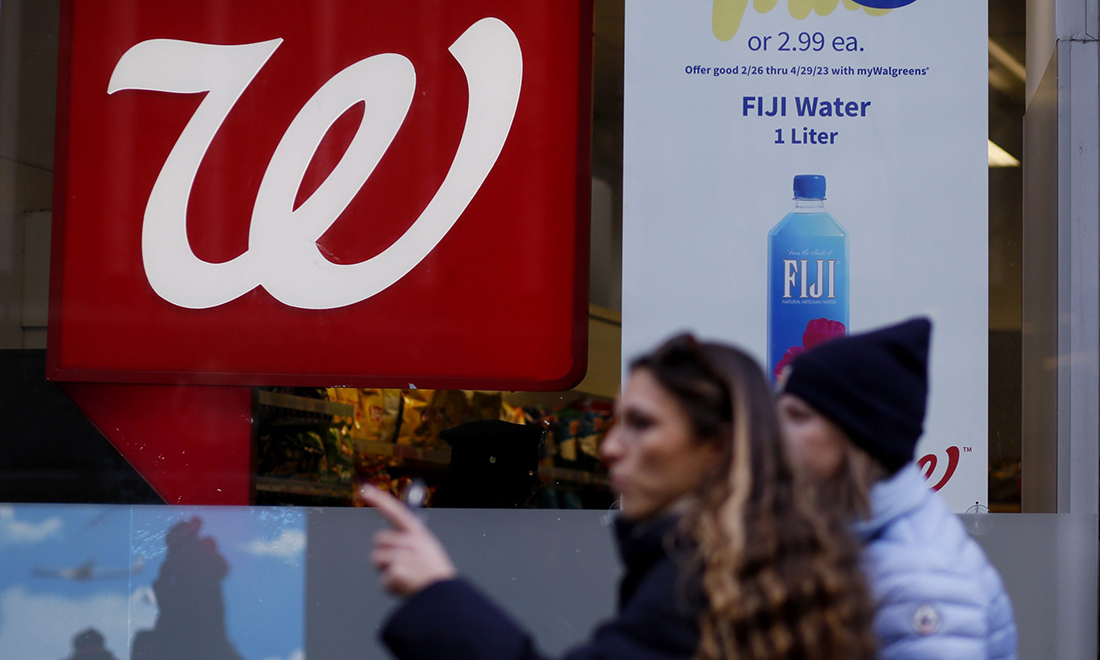
连锁药店沃尔格林上周四公布了好于预期的收益,但分析师对其能否从几年来新冠疫苗和治疗需求下降以及零售竞争加剧的挑战中恢复过来并不抱信心。
沃尔格林的收益超出预期,销售额同比增长6.3%,达到371亿美元,每股收益增长3.4%,达到1.20美元。但报告的其余部分却显示出这家公司的脆弱性:该公司报告了132亿美元的运营亏损,其中124亿美元是非现金减值支出,或与初级保健提供商VillageMD有关的注销。VillageMD计划关闭160家不盈利的门店。这些亏损促使GlobalData董事总经理尼尔·桑德斯(Neil Saunders)将本财报期称为“又一个令人不安的季度”。
桑德斯在上周四的一份报告中写道:“虽然这些都是技术性调整,但却凸显了沃尔格林过去几年做出的糟糕战略决策,以及其在医疗保健领域的种种错误行为。在新任首席执行官的领导下,沃尔格林坚定不移地将业务重心放在提高盈利能力上,而且被迫从过去被视为未来核心的业务中后退一大步。”
沃尔格林预计会遭遇挫折,特别是2月份出售药品批发公司Cencora价值9.92亿美元的股票会对收益造成打击,这促使该公司将全年调整后每股收益的上限从3.50美元下调至3.35美元。该公司希望在全年节省10亿美元。去年10月,在员工因工作条件恶劣而罢工的动荡时期后,沃尔格林首席执行官蒂姆·温特沃斯(Tim Wentworth)接任。他转而将沃尔格林未来面临的挑战归咎于零售业务,该业务因消费者不愿购买非必需品而陷入困境。
由于通货膨胀和药品成本上升,沃尔格林医药业务的销售额增长了4.7%,但零售业务的总销售额下降了4.5%。德勤(Deloitte)3月份的《消费者信号》报告显示,可自由支配支出意愿仍低于总体支出意愿,自疫情复苏以来,总体支出意愿一直起伏不定。
温特沃斯上周四在接受彭博电视台采访时表示:“我们指望人们不仅光顾药店,而且会因一时冲动购买商品,在紧急关头购买商品,或是购买季节性商品。客户必须觉得这些商品中的很多都物超所值,否则就会觉得它们可买可不买。”
其竞争对手CVS也面临着类似的困境。去年秋天,在药价上涨和对新冠相关治疗需求减少导致门店客流量放缓后,该公司也宣布缩减初级保健计划。另一家连锁药店Rite Aid也关闭了1500家门店,落入破产的境地。此外,呼吸道疾病的淡季意味着购买纸巾和非处方药的人减少了。
改变零售策略
毋庸置疑的是,沃尔格林采取了更大的举措来吸引资金紧张的客户。沃尔格林的一位发言人告诉《财富》杂志,该连锁店“通过对关键价值商品进行投资,并专注于以极其有针对性的方式与客户互动,来应对这些市场动态。”沃尔格林上个季度推出了37种新款自有品牌产品,并正在利用库存单位合理化来确定哪些产品对消费者更有吸引力。
桑德斯说,虽然客户在沃尔格林购买一般商品是出于方便,但他们也会去其他商店购买便宜商品。沃尔格林在美容领域尤其吃亏,因为消费者愿意花更多的钱,但如今这些客户却转向塔吉特(Target)和Ulta等竞争对手,后者提供更多的选择,而且价格更低。桑德斯断言,沃尔格林在零售销售方面落后并不是因为购物者不愿花钱。沃尔格林之所以亏损,是因为消费者去其他商店寻找更物美价廉的产品。
他说:“从根本上说,沃尔格林之所以亏损,是因为它不擅长零售。”
但温特沃斯强调了沃尔格林实体店的重要性,他在周四表示,沃尔格林的客户服务将它与亚马逊(Amazon)等电子商务巨头区别开来。
他对美国全国广播公司财经频道(CNBC)说:“我们将击败亚马逊,因为我们在社区和街区提供人性化服务。”
不过,桑德斯告诉《财富》杂志,沃尔格林并不以客户服务著称,由于客户经常光顾沃尔格林是出于方便,他们往往并不需要高水平的帮助。
桑德斯说:“沃尔格林认为这是该连锁店的优势领域,但这只是一厢情愿。”(财富中文网)
译者:中慧言-王芳
连锁药店沃尔格林上周四公布了好于预期的收益,但分析师对其能否从几年来新冠疫苗和治疗需求下降以及零售竞争加剧的挑战中恢复过来并不抱信心。
沃尔格林的收益超出预期,销售额同比增长6.3%,达到371亿美元,每股收益增长3.4%,达到1.20美元。但报告的其余部分却显示出这家公司的脆弱性:该公司报告了132亿美元的运营亏损,其中124亿美元是非现金减值支出,或与初级保健提供商VillageMD有关的注销。VillageMD计划关闭160家不盈利的门店。这些亏损促使GlobalData董事总经理尼尔·桑德斯(Neil Saunders)将本财报期称为“又一个令人不安的季度”。
桑德斯在上周四的一份报告中写道:“虽然这些都是技术性调整,但却凸显了沃尔格林过去几年做出的糟糕战略决策,以及其在医疗保健领域的种种错误行为。在新任首席执行官的领导下,沃尔格林坚定不移地将业务重心放在提高盈利能力上,而且被迫从过去被视为未来核心的业务中后退一大步。”
沃尔格林预计会遭遇挫折,特别是2月份出售药品批发公司Cencora价值9.92亿美元的股票会对收益造成打击,这促使该公司将全年调整后每股收益的上限从3.50美元下调至3.35美元。该公司希望在全年节省10亿美元。去年10月,在员工因工作条件恶劣而罢工的动荡时期后,沃尔格林首席执行官蒂姆·温特沃斯(Tim Wentworth)接任。他转而将沃尔格林未来面临的挑战归咎于零售业务,该业务因消费者不愿购买非必需品而陷入困境。
由于通货膨胀和药品成本上升,沃尔格林医药业务的销售额增长了4.7%,但零售业务的总销售额下降了4.5%。德勤(Deloitte)3月份的《消费者信号》报告显示,可自由支配支出意愿仍低于总体支出意愿,自疫情复苏以来,总体支出意愿一直起伏不定。
温特沃斯上周四在接受彭博电视台采访时表示:“我们指望人们不仅光顾药店,而且会因一时冲动购买商品,在紧急关头购买商品,或是购买季节性商品。客户必须觉得这些商品中的很多都物超所值,否则就会觉得它们可买可不买。”
其竞争对手CVS也面临着类似的困境。去年秋天,在药价上涨和对新冠相关治疗需求减少导致门店客流量放缓后,该公司也宣布缩减初级保健计划。另一家连锁药店Rite Aid也关闭了1500家门店,落入破产的境地。此外,呼吸道疾病的淡季意味着购买纸巾和非处方药的人减少了。
改变零售策略
毋庸置疑的是,沃尔格林采取了更大的举措来吸引资金紧张的客户。沃尔格林的一位发言人告诉《财富》杂志,该连锁店“通过对关键价值商品进行投资,并专注于以极其有针对性的方式与客户互动,来应对这些市场动态。”沃尔格林上个季度推出了37种新款自有品牌产品,并正在利用库存单位合理化来确定哪些产品对消费者更有吸引力。
桑德斯说,虽然客户在沃尔格林购买一般商品是出于方便,但他们也会去其他商店购买便宜商品。沃尔格林在美容领域尤其吃亏,因为消费者愿意花更多的钱,但如今这些客户却转向塔吉特(Target)和Ulta等竞争对手,后者提供更多的选择,而且价格更低。桑德斯断言,沃尔格林在零售销售方面落后并不是因为购物者不愿花钱。沃尔格林之所以亏损,是因为消费者去其他商店寻找更物美价廉的产品。
他说:“从根本上说,沃尔格林之所以亏损,是因为它不擅长零售。”
但温特沃斯强调了沃尔格林实体店的重要性,他在周四表示,沃尔格林的客户服务将它与亚马逊(Amazon)等电子商务巨头区别开来。
他对美国全国广播公司财经频道(CNBC)说:“我们将击败亚马逊,因为我们在社区和街区提供人性化服务。”
不过,桑德斯告诉《财富》杂志,沃尔格林并不以客户服务著称,由于客户经常光顾沃尔格林是出于方便,他们往往并不需要高水平的帮助。
桑德斯说:“沃尔格林认为这是该连锁店的优势领域,但这只是一厢情愿。”(财富中文网)
译者:中慧言-王芳
Pharmacy chain Walgreens posted better-than-expected earnings on Thursday, but analysts are not confident in its ability to recover from a challenging few years of decreasing demand for COVID vaccines and treatments and increased retail competition.
Walgreens beat earnings estimates, posting a 6.3% sales leap year over year to $37.1 billion, as well as a 3.4% earnings per share bump of $1.20. But the rest of the report tells the story of a more fragile company: It reported a $13.2 billion operating loss—$12.4 billion of which was a noncash impairment charge, or write-off related to its primary care provider, VillageMD, which plans to shut down 160 unprofitable locations. The losses prompted Neil Saunders, managing director of GlobalData, to call the earnings period “another torrid quarter.”
“While these things are technical adjustments, they underline the poor strategic decisions Walgreens has made over the past few years and its various misadventures in health care,” Saunders wrote in a Thursday note. “With the focus of the business firmly on driving profitability under a new CEO, Walgreens has had to take a very big step back from operations that it used to see as central to its future.”
Walgreens anticipated some of its struggles, particularly including an earnings hit from its February sale of $992 million in shares of wholesale drug company Cencora, which pushed the company to lower the top end of its full-year adjusted earnings per share from $3.50 to $3.35. The company hopes to save $1 billion over the course of the year. CEO Tim Wentworth—who took Walgreens’ helm last October after a tumultuous period of staff walkouts over poor working conditions—instead attributes Walgreens’ future challenges to the retail side of the business, which has struggled because of consumers’ unwillingness to buy discretionary items.
Walgreens reported 4.7% sales growth on the pharmaceutical side of the business owing to rising inflation and drug costs, but a 4.5% total sales decline on the retail side. Deloitte’s March ConsumerSignals report indicates that discretionary spending intentions are still below overall spending intentions, which have ebbed and flowed since recovery from the pandemic.
“We count on folks to come in and to not only visit our pharmacies, but come in, buy impulse items, get last-minute items, get seasonal items,” Wentworth told Bloomberg TV on Thursday. “A lot of those things are purchases that you have to get the value equation right on or else they feel discretionary to folks.”
Competitor CVS is having similar struggles. It, too, announced scale backs on primary care initiatives last fall after rising drug prices and a lessened demand for pandemic treatments slowed store traffic. Bankrupt Rite Aid, another drugstore chain, also closed a combined 1,500 stores. Plus, a weak respiratory illness season meant fewer people were buying tissues and over-the-counter medicine.
Retail strategy changes
To be sure, Walgreens has taken bigger swings to attract cash-strapped customers. A Walgreens spokesperson told Fortune that the chain is “responding to these market dynamics by making investments in key value items, and focusing our capabilities to engage with customers in a very targeted way.” Walgreens introduced 37 new store-brand products last quarter and is using stockkeeping unit rationalization to determine which products are more appealing to consumers.
While customers are buying general merchandise at Walgreens for convenience, they are going elsewhere to find bargains, Saunders said. Walgreens has particularly been losing out in the beauty sector, where customers are willing to spend more money, but are turning to competitors like Target and Ulta, which offer larger selections and lower prices. Walgreens isn’t lagging in retail sales because of shoppers unwilling to spend money, Saunders asserted. It is losing money because consumers are going elsewhere for better deals and products.
“Basically, Walgreens is losing out because it is just not very good at retailing,” he said.
But Wentworth doubled down on the importance of brick-and-mortar Walgreens, saying on Thursday that its customer service is what separates it from e-commerce giants like Amazon.
“We will beat Amazon because of the human interface that we offer in communities and neighborhoods,” he told CNBC.
Saunders told Fortune, however, that Walgreens is not known for its customer service, and because customers frequent Walgreens out of convenience, they often don’t require high levels of help.
“Walgreens’ view that this is an area of strength for the chain is a case of wishful thinking,” Saunders said.






